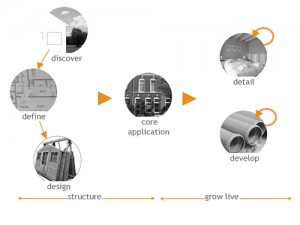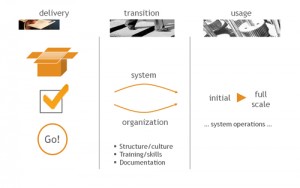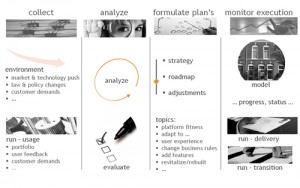Model, Run, Govern
Be Structured consists of three stages, forming a continuous cycle:
Model: Realize a customer solution with the Be Informed business process platform, mainly by modeling. Activities include: discover, define, design, detail, and develop.
Run: Delivery of the system to and usage of the solution by the end-user organization. Activities include: delivery, transition, usage.
Govern: Collects all kind of signals and formulate a proposed change, if needed. Activities include: collect & analyze feedback & new requirements, formulate plans, and monitor execution.
Phase 1 Model your business
In the modeling phase, we distinguish five stages.
In the first three stages, focus is on the problem, its scale, its scope and how it must be attacked. At the end of the design stage, there is a clear understanding of the proposed solution and its architecture. During the fourth and fifth stage we will proceed with detailing the proposed solution. The actual models on which our applications are based, are built in these stages.

Discover
The discover stage, generally runs parallel to the sales phase. Goal of this stage is to understand the real business issues and the assignment. In this stage, you decide whether you can proceed or that you should not.
The decision is based on a shared vision with the client and its major stakeholders, at least one possible solution and a feasibility assessment. Scale, scope, fit, costs and lead time are specified.
It’s a difficult stage: with little information, crucial decisions have to be made.
Define
Define is mainly about the definition of relevant objects and aspects. Goal of this stage is to envision an implementation independent business model.
The required features in a model that can also be used as a skeleton implementation are defined. This helps to understand the high level requirements and increases buy-in from major stakeholders. It also allows you to validate and improve the architecture and refine plans.
Design
Goal of the design stage is to design, implement and test the core application: an executable architecture of the business model of the previous stage.
The functionality at the application level will not be completed but an end-to-end ‘skeleton’ of the solution will be available. The application supports a variety of behavior and two to three examples of categories. If ok, we configure them all in the same manner.
In this stage too, you make critical design decisions, including the selection of technologies, main components, their interfaces and assessments of buy-versus-build options.
Detail
Goal of the detail stage is the efficient realization of a high quality Be Informed solution.
We refine and validate the coarse grained Be Informed models of the previous stage.
Authentic sources are imported and connected to the models. The required content is written. A single model with multiple views for various concerns is delivered: consistent, precise and executable.
Develop
Goal of the this last stage is the efficient realization of a high quality overall solution by developing and testing components.
The overall solution is integrated and tested. Documentation is developed, training and transition mechanisms are also part of this stage. CITA ? is needed to get agreement at every step, to get buy-in of the customer organization, to adapt to changes and to make acceptance testing the formal last step.
Phase 2 – Run your business
In this phase of Be Structured, the Be Informed solution is delivered to the customer organization. In the transition stage, the organization is prepared for full scale usage.

When the solution is delivered to the organization, acceptance is a formal step with no surprises because of the continuous testing of all intermediate products.
After formal acceptance, system transitions and organizational transformations can be finished. In this stage, lowering quality ambitions might enable learning for system operations and the support organization.
If possible, the usage stage is entered with limited scale to lower risks. For example by user category, geographic area or product type.
Phase 3 – Govern your business
To govern the organization all kinds of signals are collected, evaluated and analyzed. Hereafter a change is formulated, if needed.

Collect signals from in and outside the organization about service levels, trends and forecasts.
Analyze and evaluate your information and decide whether adjustments or new plans are needed.
Formulate plans to maintain platform fitness, adapt to changing circumstances or improve user experience.
Start over with the modeling and run phase. Monitor the stages: discover, define, design, detail & develop, delivery, transition and usage.